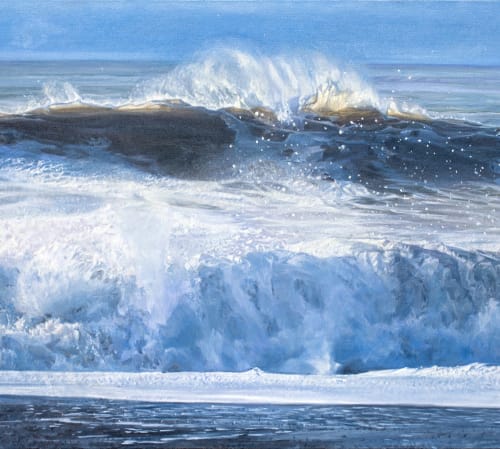Sanderson are pleased to present the exhibition Rising Tides by Freeman White.
At night, from his home on Napier’s Bluff Hill, Freeman White can hear waves breaking below on the shingle shore of Marine Parade. His connection with the ocean, his immediate environment, has provided both the motivation and subject matter for his three previous exhibitions – ‘Call of the Ocean’ (2019), ‘Deep Blue’ (2021) and ‘Salt’ (2023) - and now for ‘Rising Tides’ 2025 at Sanderson.
Several of the paintings began as en plein air studies, described by White as ‘physical embodiments’ of his memories of place, executed in situ to provide a ‘deeper understanding’ of the subject. Some of these studies are included in this exhibition. Back in the studio and along with other reference material (including photographs) taken down at the beach, they form the basis for the larger works included here.
White is dealing with an ever-changing subject: the restless ocean and the waves that end up on the western shore of the Pacific. Capturing them in all their complexity is not easy, with their inherant ephemeral nature. There are endless possibilities with each individual wave differing from all others; with the constantly changing colours and moods of the sea, and the play of light on the water. As a result - each of White’s canvas represent a unique moment in time; an arrangement of random elements that will never be repeated.
Collectively, ‘Rising Tides’ documents the life of waves, from their first appearance with the emergence of peaks, troughs and crests, to the dissipation of their immense energy as they break, crash and send slithers of creamy foam surging down the beach. All that remains of a once mighty wave, the foam inevitably dissipates and retreats, and is shortly overtaken by the next line in this never ending cycle.
These paintings are anterior views, the one exception being Homecoming, which offers an oblique perspective on an incoming and breaking wave. Unsurprisingly, given the nature of his subject, White makes great use of a limited and largely blue-based palette, along with his eponymous white pigment for churning surf and the waves’ attendant foam and flying spray. In The Sentinel, a recently broken wave floods the foreground with foam, while dark patches in the background indicate another wave is forming. The banks of waves are mirrored by the clouds overhead in Koru, while a clear line marks the upper limit of the foam as it flows up the beach. And in the largest painting in this collection, the titular Rising Tides, a dark wave surges forward, about to break, exposing its dark underbelly, while spray flies and churning surf crashes on the foreshore. The title The Wide Open acknowledges the immensity of the ocean, while others, such as Love Letter and Homecoming, reflect White’s personal attachment to his chosen subject.
All the above-mentioned canvases are based on daytime observations, except the small Moonrise Study, which captures the effects of waves under nocturnal conditions - with sea and sky appearing to merge. This work recognises the vital importance of the Earth’s natural satellite, the Moon, without whose gravitational effects there would be no tides and therefore no waves, resulting in oceans incapable of harbouring and nurturing life as we know it.
White paints the sea because, in his own words, he understands it. He needs to convey an ‘authentic feeling’, and his stated aim is to make paintings that look and feel ‘real’. To this end, a close inspection reveals brushstrokes that are clearly visible, but from a distance they merge into an overall image that is an altogether coherent, convincing and atmospheric rendition of the subject. He admits that while the ‘crashing wave’ offers unlimited opportunities for expression and abstractions in paint, it is also both ‘a beautiful and terrifying vehicle for the expression of humanity and our relationship with our environment.’
From where he stands on the shingle shore of Marine Parade, Freeman White is supplied with a continuous supply of waves, arriving as if generated by an assembly line somewhere beyond the horizon. Their unceasing activity mirrors the struggle of life within nature at large, and their constant revitalization of the oceans is essential to maintaining the Earth’s increasingly fragile and threatened ecosystems.
Richard Wolfe, June 2025.
Three poems exploring White’s paintings and the lived experience of the oceans of Aotearoa accompany this show. This includes works by Essa May Ranapiri (Ngāti Raukawa, Ngāti Takatāpui, Clan Gunn), Megan Kitching and Grace Yee.

